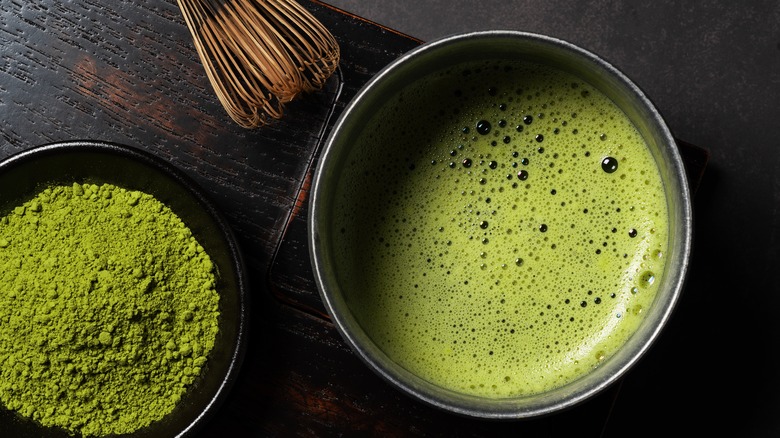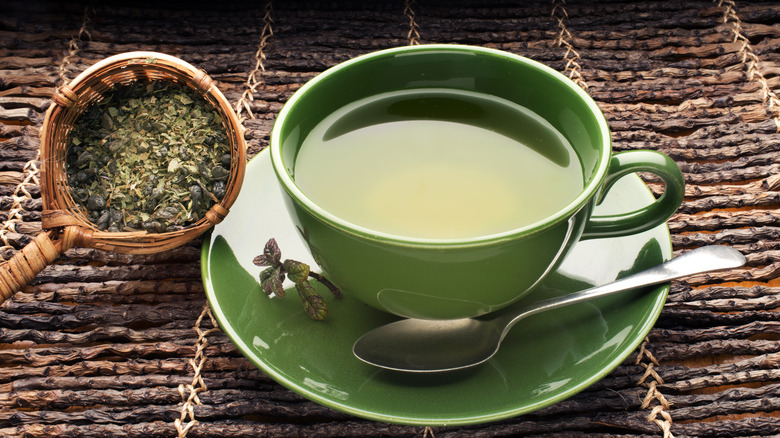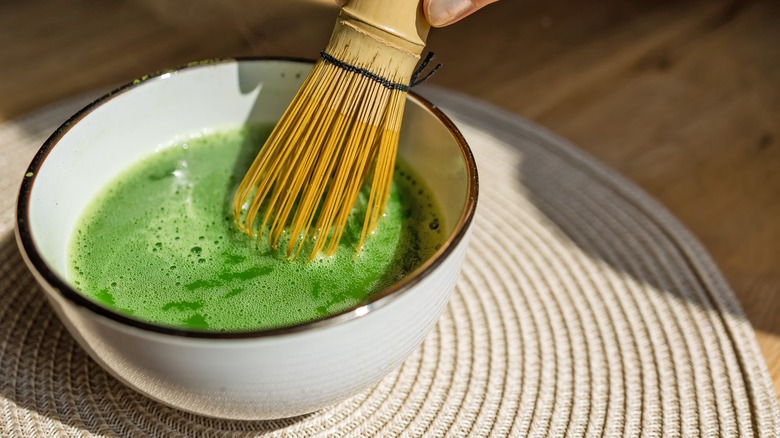What Separates Matcha From Green Tea?
We may receive a commission on purchases made from links.
Matcha has become more popular than ever in recent years, showing up on Dunkin' Donuts' menu with a shot of espresso and as an alternative to coffee at Starbucks and other cafes. However, while more people are indulging in matcha, with the market for it in the U.S. predicted to double by 2023, there is still confusion surrounding it and how it differs from green tea.
Both matcha and green tea are derived from the same plant, Camellia sinensis, but that is where their similarities end. Plants that will be turned into matcha are handled and grown differently than those destined for green tea. The plants are also harvested differently and processed differently into their final products.
Compared side-by-side, matcha appears as a bright green powder, while green tea is most commonly seen as dried, dark green leaves either loose or in bags. Moreover, green tea is a light yellow-green when brewed, while matcha retains its lime vibrancy, especially when combined with milk or cream. In terms of preparation, both can be made hot or cold, but the preparation process differs between the dried leaves and fine powder. Neither can be made the same way.
What is green tea?
Green tea is made from the dried leaves of the Camellia sinensis plant, which is also used to produce other varieties of tea, including oolong and black. However, green tea differs as it's an unoxidized tea, meaning the leaves are heated earlier during processing to force oxidation by altering enzymes before it naturally occurs. This type of tea originated in China but is now produced throughout Asia and has become popular around the globe. Plants used to make green tea are cultivated in full sunlight and take on a dull green color before they are harvested using a machine that cuts the plants. These cut leaves are then sent to a processing facility to be steamed and turned into packed or loose-leaf tea.
As for preparation, green tea is best brewed in water just below boiling, at around 180 degrees Fahrenheit, to prevent it from becoming bitter. If the water is too hot, it can cause the leaves to release tannins, causing the less-than-desirable bitter aftertaste. When brewed correctly, both hot and iced green tea have a mild, refreshing flavor with a slight earthy undertone. As for caffeine, green tea has about half the amount you would find in black tea and only a quarter the amount in coffee.
Additionally, green tea contains several important nutrients, including trace amounts of magnesium, iron, and potassium. It also contains the antioxidant catechin Epigallocatechin-3-gallate, which has been linked to increased cognitive function, digestive health, regulated blood sugar, and improved cardiovascular health. However, matcha actually has more of these nutrients, as when seeped leaves are removed from a cup of green tea, some nutrients go with them.
What is matcha?
Matcha, like green tea, is made from Camellia sinensis. However, instead of spending their entire lives in the sun, the plants used for matcha are grown in the shade for three weeks before harvest. This increases the chlorophyll in the leaves, turning them a vibrant green. At harvest, the leaves for matcha are picked by hand, heated, and dried, then the stems and veins are removed before the leaves are ground into a fine powder. Moreover, while green tea originated in China, matcha is primarily made in Japan.
Unlike green tea, matcha is traditionally whisked into hot water using a chasen, a bamboo whisk, like this one from Jade Leaf Matcha. Alternatively, an electric frother can be used to remove any powder clumps. However, matcha can also be prepared iced using a shaker bottle. Because it is a powder, matcha is much more concentrated than seeped tea leaves. This means it has a much bolder flavor that can be rather intense depending on the amount used. That said, this robust and earthy flavor is what makes it perfect for blending with milk into a velvety latte.
Another thing that makes matcha stand out is its high nutritional content, which can be three to 10 times the amount in seeped green tea. This is because when drinking matcha, you consume the dissolved ground leaves instead of removing them like a tea bag. Likewise, matcha boasts more caffeine than standard green tea and about half the amount coffee does.


